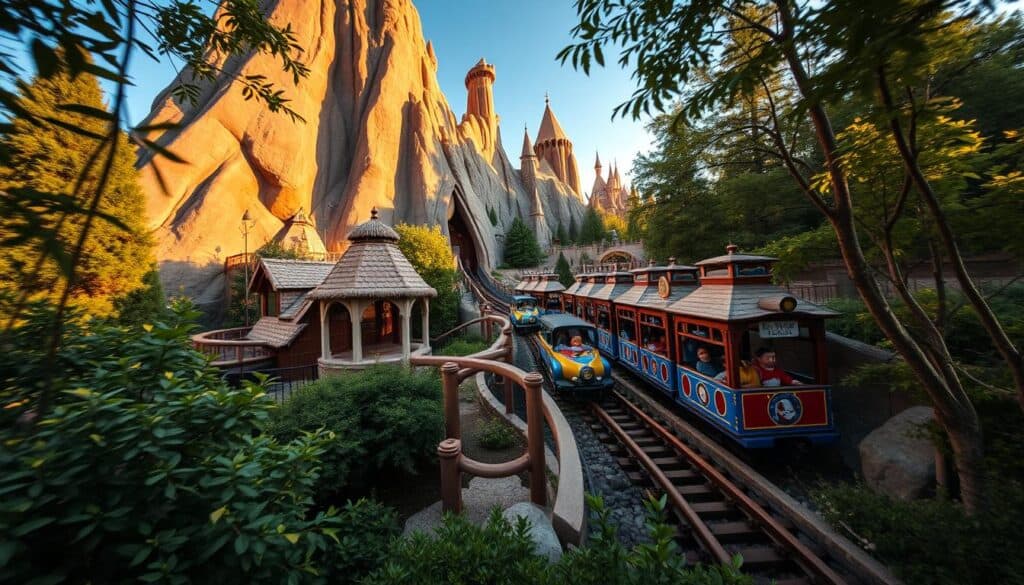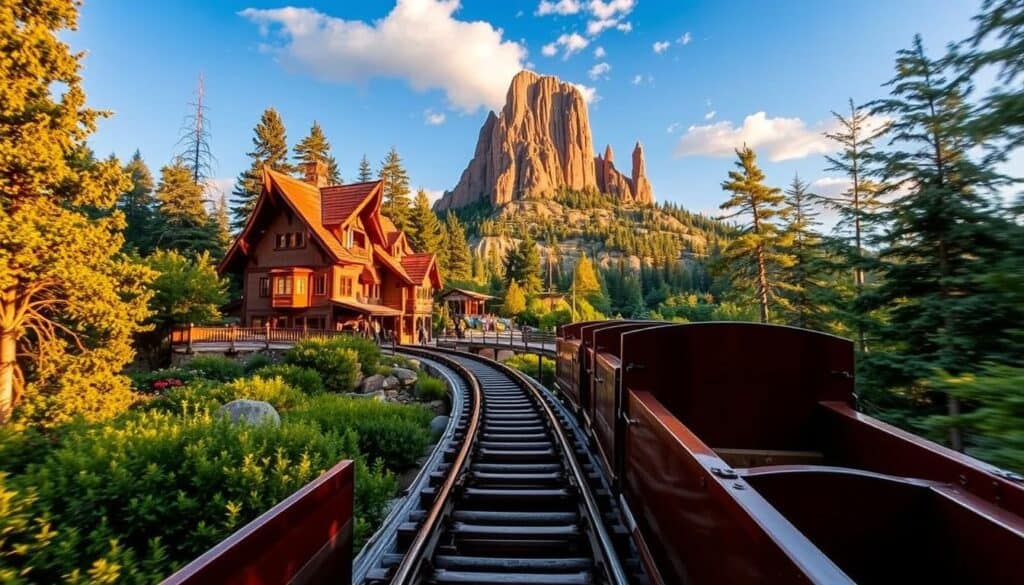Located in the heart of Magic Kingdom, the Seven Dwarfs Mine Train is one of Walt Disney World’s most beloved attractions. This unique ride combines the excitement of a roller coaster with the immersive storytelling of a dark ride, making it a must-experience for visitors of all ages.
Connected to the timeless tale of Snow White, the Seven Dwarfs Mine Train brings the classic story to life with cutting-edge technology and imaginative design. The ride’s innovative blend of coaster thrills and dark ride elements creates an unforgettable adventure that appeals to both families and thrill-seekers alike.
Step into a world of enchantment as you explore the meticulously themed mine, complete with dynamic scenery and interactive elements. The ride’s attention to detail, from the sparkling gemstones to the lively Audio-Animatronics of the Seven Dwarfs, ensures an immersive experience that captures the magic of Walt Disney’s legacy.
As part of the New Fantasyland expansion, the Seven Dwarfs Mine Train has become a modern classic, offering a family-friendly coaster experience that’s perfect for all ages. Whether you’re a first-time rider or a seasoned park-goer, this attraction promises a memorable journey filled with wonder and excitement.
Key Takeaways
- The Seven Dwarfs Mine Train is a hybrid roller coaster and dark ride located in Magic Kingdom.
- It combines thrilling coaster elements with immersive storytelling inspired by Snow White.
- The attraction features detailed theming, Audio-Animatronics, and interactive elements.
- Designed for families, it offers a fun experience for both children and adults.
- It is part of the New Fantasyland expansion, making it a modern Disney classic.
Magical Overview of the Attraction
Step into a charming realm where fantasy meets adventure at the Seven Dwarfs Mine Train. This beloved attraction, nestled in the heart of Magic Kingdom, is a cornerstone of the New Fantasyland expansion. It masterfully blends the nostalgia of classic tales with modern innovation, creating an experience that captivates visitors of all ages.
Attraction Background and New Fantasyland Connection
The Seven Dwarfs Mine Train is a testament to the evolution of themed entertainment. Part of the New Fantasyland expansion, it reimagines elements from earlier attractions like Snow White’s Scary Adventures, weaving them into a fresh, immersive experience. The ride’s design draws inspiration from the 1937 classic, Snow White and the Seven Dwarfs, bringing the story into the 21st century with cutting-edge technology and creative storytelling.
Theming, Storytelling, and Immersive Details
From the moment you enter, the queue sets the stage with intricate theming that transports you to the dwarfs’ cottage. The ride’s mine train vehicles, designed to swing gently, enhance the journey through a gem-filled mine. The combination of Audio-Animatronics and dynamic scenery creates an engaging environment that feels like stepping into a living fairytale. The attention to detail, from sparkling gems to lively character interactions, ensures every moment is memorable.
This attraction stands out for its unique blend of family-friendly thrills and enchanting storytelling, making it a must-visit for any Disney enthusiast.
In-Depth Review of disney world 7 dwarfs mine train
Discover the enchanting blend of thrills and storytelling at the Seven Dwarfs Mine Train in Magic Kingdom. This unique attraction seamlessly merges the excitement of a roller coaster with the immersive elements of a dark ride, creating a captivating experience for visitors of all ages.
Coaster and Dark Ride Hybrid Experience
The ride’s design stands out with its smooth transitions between outdoor coaster segments and indoor dark ride scenes. The rapid pace and precise timing keep riders engaged, with key moments that make each minute of the ride memorable. The mountain track offers expansive views of Fantasyland, enhancing the thrill factor while maintaining a family-friendly experience.
Audio-Animatronics and Scenic Visuals
The state-of-the-art Audio-Animatronics bring the story to life, with the Seven Dwarfs and other characters showcasing fluid movements. The scenic visuals, including sparkling gems and lively scenes, create an immersive environment that feels like stepping into a fairytale. While the mine scene is brief, the attention to detail ensures a memorable experience.
| Feature | Seven Dwarfs Mine Train | Other Magic Kingdom Coasters |
|---|---|---|
| Thrill Level | Family-friendly | Varies (e.g., more intense) |
| Ride Duration | Approximately 3 minutes | Varies by attraction |
| Key Elements | Hybrid coaster-dark ride, swinging vehicles | Diverse, from high-speed to themed experiences |

This attraction’s unique blend of coaster thrills and dark ride storytelling makes it a standout experience in Magic Kingdom, perfect for families seeking a fun and memorable adventure.
Pros, Cons, and Rider Perspectives
Guests at the Magic Kingdom often share mixed feelings about the Seven Dwarfs Mine Train. While many praise its immersive theming and family-friendly thrills, others note a few drawbacks.
Highlights and Standout Features
The ride’s queue and scenic details are often highlighted as standout features. Guests appreciate the interactive elements and the lively Audio-Animatronics. The swinging mine cars add a unique touch, making the experience more engaging for riders of all ages.
Challenges: Ride Duration and Comfort Issues
One common criticism is the ride’s short duration, lasting just under three minutes. Some guests also mention that the seating can be a bit cramped, especially for taller riders. However, these aspects don’t deter many from enjoying the attraction.
| Feature | Seven Dwarfs Mine Train | Other Magic Kingdom Coasters |
|---|---|---|
| Thrill Level | Family-friendly | Varies (e.g., more intense) |
| Ride Duration | Approximately 3 minutes | Varies by attraction |
| Key Elements | Hybrid coaster-dark ride, swinging vehicles | Diverse, from high-speed to themed experiences |
Overall, the Seven Dwarfs Mine Train remains a beloved attraction, offering a magical blend of storytelling and thrills that appeal to a wide range of guests.
Insider Tips and Ride Strategy
Planning your day at Magic Kingdom? Make the most of your time on the Seven Dwarfs Mine Train with these expert tips. Early arrival is key—reach the park at opening to enjoy shorter lines. Consider using Genie+ Lightning Lane passes for faster access, especially during peak times.
Best Times to Beat the Lines
The best times to ride are early in the morning or later in the evening. Weekdays tend to be less crowded than weekends. If you’re visiting during holidays, plan your ride for the first hour after park opening to avoid long wait times.
Navigating the park area efficiently can save you a lot of time. Head straight to Fantasyland as soon as you enter the park. The ride vehicles are designed for comfort, so choose a seat that suits your preference for a smoother experience.
Families with young children can take advantage of the rider switch option, allowing adults to take turns. Solo riders can use the single-rider line if available, which is often quicker. A little planning can make a big difference in your day, reducing stress and saving you time.
Adjust your itinerary based on real-time crowd conditions. Busy days require more strategy, so keep an eye on the park’s crowd calendar. With these tips, you can enjoy a memorable experience on the Seven Dwarfs Mine Train without the hassle of long waits.

Behind the Magic: Technology and Hidden Details
Ever wondered what makes the Seven Dwarfs Mine Train so enchanting? The answer lies in its cutting-edge technology and clever design elements. This section takes you on a journey to uncover the innovative mechanisms and hidden gems that bring this attraction to life.
Innovative Ride Mechanisms and Thematic Elements
The ride’s smooth and dynamic motion is made possible by a track-mounted pivot system. This innovative engineering allows the mine train vehicles to sway naturally, enhancing the overall experience. The motion is so fluid that it feels almost like a real mine cart journey, making every twist and turn exciting yet comfortable for all ages.
The theming is another standout feature. From the moment you step into the queue, you’re immersed in the dwarfs’ world. The mine’s exterior lighting transforms the attraction at night, creating a dazzling display that adds to the magic. These technical and thematic details work together to create an unforgettable experience.
Easter Eggs and Hidden Mickeys
Eagle-eyed visitors will love the hidden details scattered throughout the attraction. Look closely, and you might spot classic Disney characters cleverly integrated into the scenery. These Easter eggs and Hidden Mickeys are a fun challenge for fans, adding an extra layer of enjoyment to the ride.
The blend of creativity and engineering excellence sets this ride apart. With its unique motion systems, immersive theming, and hidden surprises, the Seven Dwarfs Mine Train offers a one-of-a-kind experience that captivates visitors of all ages.
Conclusion
As we conclude our journey through the Seven Dwarfs Mine Train, it’s clear why this attraction holds a special place in the hearts of many. Combining timeless storytelling with modern innovation, the ride offers a magical experience that appeals to all ages. From the swinging mine cars to the lively Audio-Animatronics, every detail has been crafted to create an immersive adventure.
Guests have shared their thoughts, praising the ride’s enchanting theming and family-friendly thrills. While some note the short duration and snug seating, these aspects don’t overshadow the overall charm. The ride’s ability to blend coaster excitement with dark ride storytelling makes it a standout attraction in Magic Kingdom.
Whether you’re a first-time visitor or a seasoned fan, the Seven Dwarfs Mine Train is a must-try. Its lasting appeal lies in its ability to bring joy and wonder to everyone who experiences it. So, the next time you’re at Magic Kingdom, make sure to step into this whimsical world and create memories that will last a lifetime. It’s a ride that reminds us why Disney continues to be a leader in imaginative storytelling and innovation.
We’d love to hear your thoughts! Share your experiences with the Seven Dwarfs Mine Train in the comments below and join the conversation with our community of Disney enthusiasts.
FAQ
What is the height requirement for the Seven Dwarfs Mine Train ride?
The height requirement for the Seven Dwarfs Mine Train is 38 inches. This ensures a safe and enjoyable experience for all riders.
How long does the ride last?
The ride duration is approximately 5 minutes, making it a great option for guests of all ages who want a fun but not overly long experience.
What is the best time to ride the Seven Dwarfs Mine Train?
The best times to experience the ride with shorter wait times are typically early in the morning or late in the evening. Avoid peak afternoon hours when lines are longest.
Is the ride suitable for young children?
Yes, the Seven Dwarfs Mine Train is designed to be family-friendly. However, it’s recommended for children who are comfortable with gentle drops and turns. Parental discretion is advised.
Can I experience the ride if I have mobility issues?
The ride vehicles are designed to accommodate guests with certain mobility needs. Be sure to speak with a cast member for assistance with ride vehicle access or special arrangements.
Are there any hidden gems or Easter eggs in the ride?
Yes! Keep an eye out for hidden Mickeys and references to the classic Snow White film throughout the queue and ride scenes.
How does this ride compare to other Magic Kingdom attractions?
The Seven Dwarfs Mine Train is a unique blend of a coaster and dark ride, offering a smoother experience compared to more intense coasters like Space Mountain. It’s a great middle ground for families.








